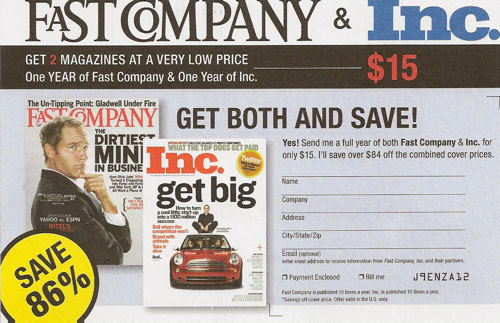
I love magazines.
Despite most days feeling like someone pushed the self-destruct button and we’re all scrambling for the escape pods—cue Whitney—I will always love them, especially and above all, the printed format.
I’m no fetishist or luddite, though, and while I tend to favor print, my definition of a magazine is platform neutral. I’ve worked in magazine publishing for over 15 years now—from audience development to advertising sales, freelance editorial to events planning, corporate to DIY—and stand firmly with the digital generation that’s purportedly out mugging elderly newspapers in broad daylight, and striking fear in the hearts of cowardly and superstitious magazines in the middle of the night.
Seeing subscription offers like the one above for Fast Company and Inc.—two solid print magazines devaluing their editorial content at only $.75/issue while simultaneously making it all available for free online—I think that the death of the current ad-supported model is inevitable and, arguably, a good thing.
Portability and endurance are two theoretical advantages that print magazines have over their digital competitors, but the ability to deliver engaging, focused and original content cheaply and on a consistent basis is much harder to do in print than it is online, where expectations are lower and the exchange rate is more favorable. Paradoxically, magazines’ own online presences are, more often than not, commensurable partners at best, if not outright parasites.
In a typical ad-supported print magazine, even the best editorial intentions are constricted by the costs of printing and postage which are subsidized by the diminished and ever-fluctuating advertising revenues that ultimately dictate page counts. They’re further contradicted by mixed messages about the actual value of the content itself, as in the insulting subscription offer above.
I was doing some Spring cleaning this weekend, and part of it involved going through the ridiculous piles of magazines that had accumulated around the house over the past several months — a wide range of titles reflecting personal interests, competitive research, random newsstand browsing, and “forced-free trials”. While sorting them into save and recycle piles, I was struck by how many of them I hadn’t flipped through yet or even recalled pulling out of the mailbox, including some of my supposed favorites.
The pile of unread copies of The Atlantic dating back to last Fall was perhaps the most galling since I often note it as one of my absolute favorites, subscribing last Spring after picking up several issues on the newsstand, and renewing early for a three-year term. And yet, its exemplary collection of well-written, long-form journalism rarely gets more than a quick flip-through when it shows up in the mailbox, set aside to read when I have more time that never seems to materialize.
Coincidentally, I also subscribe to Andrew Sullivan’s Daily Dish (via Google Reader and, for a short while, on Twitter), but the volume of content he generates can be overwhelming, and I’ve found myself lately only skimming headlines and rarely clicking through to read full posts. While his purposefully fleeting bits of data, links and reflexive commentary are of a higher quality than some magazines’ feature articles, they’re usually buried under his steady stream of content by the end of the day, unlikely to ever be seen again, except possibly via a relevant Google search somewhere down the road.
I ended up saving most of the unread copies of The Atlantic, fully expecting to read and enjoy them in the near future, partly based on past experience with the magazine itself, and partly from having The Atlantic brand and what it represents steadily drummed into my head every day, courtesy of Sullivan and Ta-Nehisi Coates‘ hyperactive RSS feeds.
Meanwhile, included in the recycle pile were several copies each of New York, W and Wired, three magazines I started receiving, unrequested, out of the blue a while back. New York and Wired weren’t totally unreasonable guesses based on surface demographics—I’m assuming they both pulled me from The Atlantic‘s mailing list, or possibly The New Republic—but I actively hate the former’s editorial focus, and the latter is an occasional newsstand pickup whenever the cover looks interesting. W, though, made absolutely no sense at all and represents the kind of junk mail “audience development” that fluffs up far too many magazines’ mailing lists for advertisers’ benefit — missing rate base means make-goods and deeper discounts — and ultimately hurts them both in the end when complaints about a lack of ill-defined results leads to a vicious cycle of even lower ad rates and a further devaluing of content.
One unrequested magazine actually made it to the “save” pile, thanks to my wife. Gourmet was sent to me—almost as much of a reach as W—but after a couple issues, she was intrigued enough that we might actually subscribe to it for real, assuming they don’t just keep sending it to us for free.
Notably, I don’t regularly (if ever) visit any of these brands’ websites and wouldn’t pay to access their content online, though Gourmet at least has the potential to develop a multi-platform option that would appeal to my wife.
I’m not a fan of using one’s own habits as a benchmark, but I suspect there’s a lesson here for publishers and marketers alike: impressions have nothing to do with engagement, and in the end, engaging content appropriately packaged will find its audience.
That’s a victory for quality content curated with an emphasis on a specific community over generic demographics, but it poses a serious dilemma for publishers who are overly dependent on advertising and have conditioned readers to expect to pay as little as possible, if anything at all, to receive that content.
The one question so few publishers want to answer but can no longer avoid is, how much is their magazines’ content really worth?
More on that later this week…
Do you like email?
Sign up here to get my bi-weekly "newsletter" and/or receive every new blog post delivered right to your inbox. (Burner emails are fine. I get it!)

